
Why Counteroffers are a Horrible Retention Strategy (And What to Do Instead)
During a recent conversation I had with a colleague and VC powerhouse, I heard something that seriously blew my mind:
In just the last month, five accepted job offers with established start dates were on the table with their portfolio companies for VP’s of Sales. And they all blew up in the 11th hour due to counteroffers from the candidates’ current employers luring them to stay.
Each hiring company was left in disarray and scrambling to put the pieces back together while figuring out how to hire while recouping the lost time — and they were already struggling due to not having the right VP of Sales in place.
But guess what?
They’re not the only ones who will be feeling the repercussions of these dreaded counteroffers.
Know why?
Because counteroffers appear like shiny miracle workers on the surface, but more times than not, they spell D-O-O-M for employees and their employers alike, as you’ll learn in this guide.
I’m here to help and will be diving into why counteroffers are horrible for retention, what to do if you’re faced with this situation, and nine tips to help prevent them from striking.
Let’s jump into the brass tacks, shall we?!
The Cold Hard Stats On Counteroffers and Why They Rarely Work for Retention
I get it, with 15+ million (and counting) people quitting their jobs since April, it’s a tempting strategy.
Counteroffers are merely a fear-based reaction to an all too familiar situation that happens far more often than they should.
Either executives really can’t stand to lose their employees, or they’re only biding their time until they can hire someone to replace those that were ready to leave.
In the end, it really doesn’t matter why employers take this route for retention.
The counteroffer strategy rarely works.

And if you don’t believe me, check out the statistics showing:
- 89% of employees who took a counteroffer left the position within six months
- 93% quit within 18 months
- Just 7% actually stayed
Additional research says:

Case in point: I was working with a startup to place a VP of Customer Success who had three stellar people at the finish line but only one open role.
This third person was that good that they decided to create a role for her, which she happily accepted. That is, until a counteroffer came up.
She backed out of the newly created role, took the counteroffer, and ran off.
But that’s not where the story ends.
As expected, the counteroffer didn’t fix everything. She came crawling back six months later hoping to revisit the position the new company tried to create for her.
Bad news: that ship had sailed and they found someone else.
So, lesson learned: if you’re going to keep the possibility of an open door for someone (only do this if they’re that good), remind them that things quickly change and often do.
So why don’t employees stick around when employers throw a bunch of cash their way with big promises while attempting to match the other bells and whistles scored in the new position?
Because:
The Problem is Rarely About Pay
Unless an employee will be earning a substantial amount more elsewhere, jumping ship is rarely just about the salary.
Sure, a higher salary is enticing, but the trigger to job hunt probably goes much deeper than that.
The fact is: people quit their boss AND their job.
Deeper issues like these are much more likely to be at play:
- Poor leadership
- Lack of product-market fit
- Lack of professional development or direction
- Not feeling appreciated or valued
- Not working on meaningful projects or feeling like their work contributes
- Lack of flexibility
As you can see, none of those problems have anything to do with earning more money.
Fact: money doesn’t fix what’s broken.
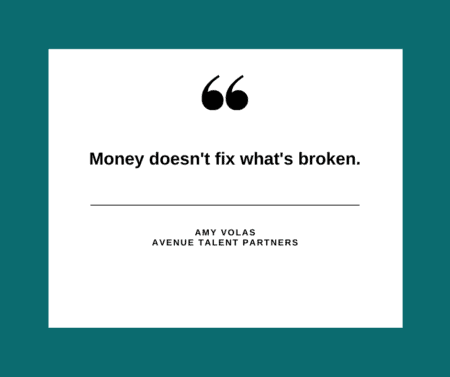
On top of that…
Counteroffers Set a Terrible Example for the Team
It’s important to remember the criticality of setting expectations early and often. Every decision you make as a leader reinforces this.
So, let’s say you do concede to giving someone more money to keep them on board. Imagine what kind of example this sets for the rest of your team!
If all they have to do is go out and find another job offer to get a raise and some leverage to stay put, don’t you think they’ll all want to do so?
Of course they will!
And guess what? Your loyal employees who don’t do this will only build resentment and distrust, making it a true lose-lose.
If they see their coworkers pretending to leave to get a pay raise while they happily stay put with their current compensation plan, they’ll feel slighted when you give in (and how could you blame them?).
You can see how this will snowball into bigger problems, create more unhappy employees, leading to more costly turnover.
Finally…
Counteroffers Break Trust
Can you ever fully trust an employee who went so far as to interview at other companies and accept an offer?
Would you believe they wouldn’t do this again?
Are you truly committed to their success or responding out of fear?
In the back of your mind, you’d probably wonder whether they’re simply collecting a paycheck until the next lucrative job offer crosses their path.
And if it did, would you counter again?
Instead of investing your time and effort into this employee, you’ll always be on edge about when they’re going to leave you and your team high and dry, which is definitely bad for morale and team building.
Or you’ve already started hatching plans to replace them and looking at their prolonged stay from accepting the counteroffer as a “bridge.”
“What’s important to remember is trust isn’t given, it’s earned. It’s not earned through words, it’s earned through actions. It takes years to build up trust in any relationship and only seconds to destroy it, but forever to repair it. And the reality is, it may never be the same again. So remember, we can’t always demand trust, when we haven’t always offered the truth.” – Dhar Mann
To recap, counteroffers are a terrible retention strategy because:
- They act as a bandage that doesn’t ever solve the real problem
- They set a horrible precedent for other employees to follow
- Trust is damaged
I know what you’re thinking at this point — That’s great, Amy. I totally get what you’re saying about why counteroffers are bad, but what do I do if I’m faced with one? Will I lose a fantastic employee if I don’t counter?
Keep reading…
What To Do If You’re Faced with a Resignation
Do not, and I mean DO NOT, throw money at this problem.
Yes, it might seem easier to quickly sweep this issue under the rug and match or surpass your employee’s pay terms.
But I promise you this will only bury the problem in the short term and it will resurface again later. Besides, stats show this employee is much more likely to leave anyway.
So what’s the best route to take here?
Have a sit down with them to gain more insight on what’s really going on.
- Do they feel overworked, under-appreciated, or both?
- Are they struggling to get along with a particular executive?
- Do they feel like they’re not seen, heard, or understood?
- Are you not aligned?
- Do they need more flexibility in their role or the option to have a more flexible working environment?
Once you learn the root issue, you can then see whether it’s in your power to fix it.
Alignment is the new loyalty.
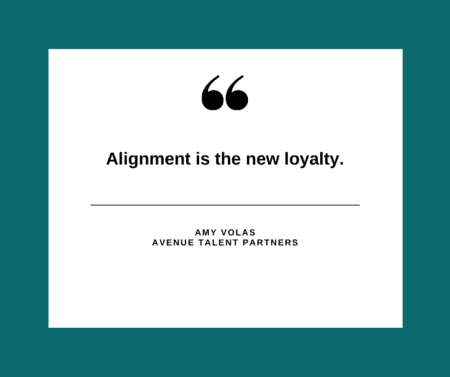
If you can get to the root to truly address the issue(s) — pinpointing product obstacles, offering more flexibility, enabling the team with the proper infrastructure and technology, giving more recognition — present an actionable plan to do so.
If you genuinely can address what’s broken with actionable next steps and an efficient plan, see if this talented employee will be willing to give it another shot with what you realistically CAN do. Whatever you do, make sure this plan is implemented and followed through on, or you’ll be in this same boat in the blink of an eye.
Now, you may find that there are variables you just can’t compete on — such as travel expectations, product-market challenges, key hires you don’t have the resources to hire, the appeal of a new industry, or even a promotion. That’s okay! In this case, it may be best to part ways and leave on good terms.
If your timing is off, you can’t reconcile what’s broken, and this person is truly valuable to your organization, don’t let your ego or emotions ruin the relationship. It’s a big, small world and you want to leave the door open for opportunities down the line. They could be someone you work with again in the future, a referral partner, a customer…
In an ideal world, you’d proactively work on retention strategies that ensure this situation never comes up.
And I’ll show you nine surefire ways to do that next.
How To Get Ahead of a Resignation Before It Has a Chance to Strike
The decisions you make shape what happens in the future.
No one can predict when a resignation will happen. But you can do everything in your power to make sure people aren’t tempted to look elsewhere.
After all, if you make your company the best place where employees can thrive, why would they want to leave?
Ultimately people want to be seen, heard, and understood. Our employees are no exception to that rule. Understanding to create alignment with your employees’ needs and career development will make them much more likely to stay for years to come.
Truth:

So let’s talk about how to breed these happy, loyal team members.
1. Be Proactive About Taking Care of Your Employees
Paying a fair, competitive wage is the first step toward taking care of your employees. This sends the message that you value their efforts and you know what their hard work is worth.
But this is just the beginning of taking care of your people.
On top of paying them well, it’s crucial that you understand what’s important to them. This is where show versus tell comes into play.
Show them you want to invest in them and help them further develop their skills and career. Collaborate with them on projects that elevate their exposure within the company while boosting their skills at the same time.
Research shows 70% of employees say they’re somewhat likely to leave their current employer for a new company that will invest in their learning and development [*].
So consider offering career development in the form of mentoring, career coaching, providing continuing education, or reimbursing them for formal/online classes.
All these investments will help your team evolve, raising the bar for your company’s overall skill set and productivity. It also pays off when it comes to loyalty.
2. Enable Your Team Members
Giving your employees the tools they need to succeed and actually letting them do so can go a long way for keeping them around.
So make sure you’re providing your team with everything they need to grow and blossom in their roles.
While it’s hard to let go of the reins, especially for Founders, if you hire the right people, you have to then trust them to do well.
This empowers team members and helps them build confidence, two things that will help boost morale, improve their problem-solving capabilities, and instill loyalty in you and your company.
3. Dig Deeper Into Their Skill Set
It’s also a good idea to spend time harnessing your employee’s untapped potential.
While you may have hired them for one skill set, chances are they have other skills just waiting to be used.
You may also find that they excel in an area you never even considered using them in, which can be helpful for all parties involved.
By digging deeper to see what else is under the surface, you’ll give your employees the opportunity to flex their myriad talents. And the more skills they can successfully use, the more fulfilled in their role they may feel.
So get to know your team members by using this tip and the next one:
4. Create a Roadmap and Check-In Regularly
Mapping out a clear career path together is a must-have ingredient for keeping lurking offers off the table.
With this roadmap, your employees will have a sense of direction and specific end goals to work toward. They’ll also feel more aligned with their work instead of feeling trapped in a never-ending Groundhog’s Day loop.
But you can’t just create a roadmap and take a set-it-and-forget-it approach.
You must check-in often to see how things are going and make adjustments as needed.
Try to get feedback from your team regularly on a formal and informal basis and tune into the themes, so you’re aware of hiccups or setbacks long before they turn into problems that cause people to seek new employment.
Make sure these conversations show your employees that the work they do matters, lean into accountability and ownership on both sides of the table, and talk with them not at them to dig into why what they’re doing matters. When employees feel this, they’ll be more committed and more likely to stick around long-term.
Plus, if you have employees on continuing education or development paths, these check-ins will allow you to see how they’re progressing. Then you can figure out where to use their additional education and skills.
Do this, and you’ll have a more productive team who know where they’re going and are happy to evolve with your company instead of staying stagnant or looking for the next greener pasture.
5. Give Recognition, Kudos, and Praise Regularly
Be honest: How often do you show your appreciation for all your employees’ hard work?
Feeling under-appreciated or undervalued are two of the biggest drivers of why people leave a company.
So, by making it a point to regularly give kudos, you’ll show employees exactly how much you notice and appreciate their sweat and dedication.
Your kudos don’t have to be elaborate — they can be as simple as an email or Slack shout-out — just make sure you’re being specific and consistent about what is standing out and why it matters.
Be sure to rotate your recognition so you’re not alienating other talented gems on the team. The last thing you want to do is to create a sense of favoritism or keep giving one person all the applause for a team effort.
6. Promote from Within
Next time you have a new role to fill, see if you can promote someone from within FIRST.
Promotions help people feel as if their career can progress with your company, building loyalty and hope for advancement.
While someone may not have the exact skill set right away, you may be able to train them to do what you need, especially if they’ve taken your offer for continuing professional development.
If employees know they can advance within your company, they’ll be more likely to do so than jump ship.
7. Get Feedback from Your Team and Put It to Good Use
Building a culture of accountability and transparency is a big deal and reinforced by how you’re giving and receiving feedback and what you’re doing with that information.
Regularly checking in with your employees gives you a chance to solicit actionable feedback and see how things are going.
This insight will help you pinpoint themes, identify problems early on, and fix them before they get out of hand.
If you don’t identify and address issues, you’ll inadvertently send your employees looking for other work, creating a revolving door of people leaving behind a trail of costly and painful consequences for your team, buyers, and business.
Not only that, you may lose people to the same issues time and time again when you fail to handle them properly.
So create an environment where your team feels comfortable giving you their input. Then be willing to listen to their feedback and make changes to help your organization grow and improve.
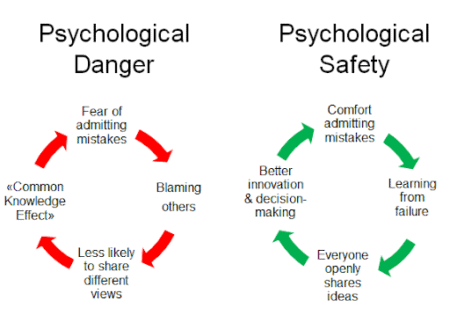
8. Incentivize the Behavior You Want to See Through Compensation
While I mentioned that money is often not why people leave, that doesn’t mean you should clip their wings.
Paying people fairly, NOT reducing their pay because they moved to a different city during COVID, catching employees up if you had to cut during COVID, not changing compensation plans every other quarter that makes it more difficult to achieve success and payouts, and removing accelerators are ways to keep your team motivated to stay.
To take this a step further, consider a system for increasing salaries based on whether employees opt for continued education or actively engage in improving their performance.
After all, if your team is expanding their skill set, their annual raises should adjust for these factors.
This should entice and encourage people to put in more effort to earn more instead of just sitting back to collect a paycheck.
In return, you’ll have the team investing more in your company, which should generate more revenue for you to cover these increases and then some.
9. Consider Offering More Flexibility
Finally, flexibility (or a lack thereof) is another big factor that leads people to switch employers.
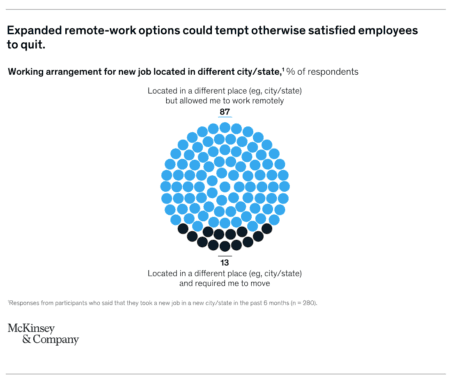
A typical 9 to 5 schedule or going into the office five days a week may not work for everyone, especially parents, and it could lead to burnout for others.
Flexibility has a variety of options… Many employers are experimenting with four-day workweeks, flexible work arrangements with hybrid models, open-ended schedules, mental health “recharge” days, lighter day schedules (9 to 3 one day a week)…
This is the time to ask your team for feedback about what they think would improve their work-life balance. Listen, look for the themes, and respond accordingly. Even if you can’t accommodate every single person or every single request, showing that you heard them, demonstrating what you can do, and why makes an incredible difference.
These nine strategies will do more for your retention rate than wasting money on any counteroffer. And if you implement them ASAP, your team will find it difficult for other companies to ever compete on your level.
Final Thoughts on Why Counteroffers are a Horrible Retention Strategy
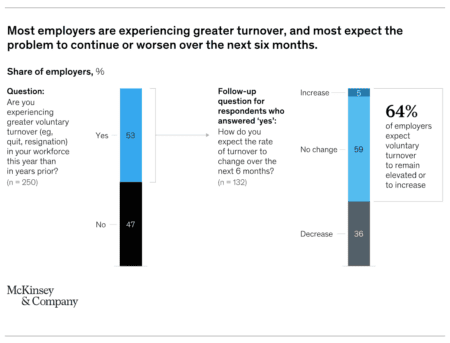
After reading this guide, you’re now equipped with all the information you need to handle a resignation successfully and how to stay ahead of avoiding it!
Simon Sinek said it best:
“If you hire people just because they can do a job, they’ll work for your money. But if you hire people who believe what you believe, they’ll work for you with blood and sweat and tears.”
The faster you create an environment where people can thrive while enjoying being there at the same time, the less you have to worry about employees leaving or “The Great Resignation.”
